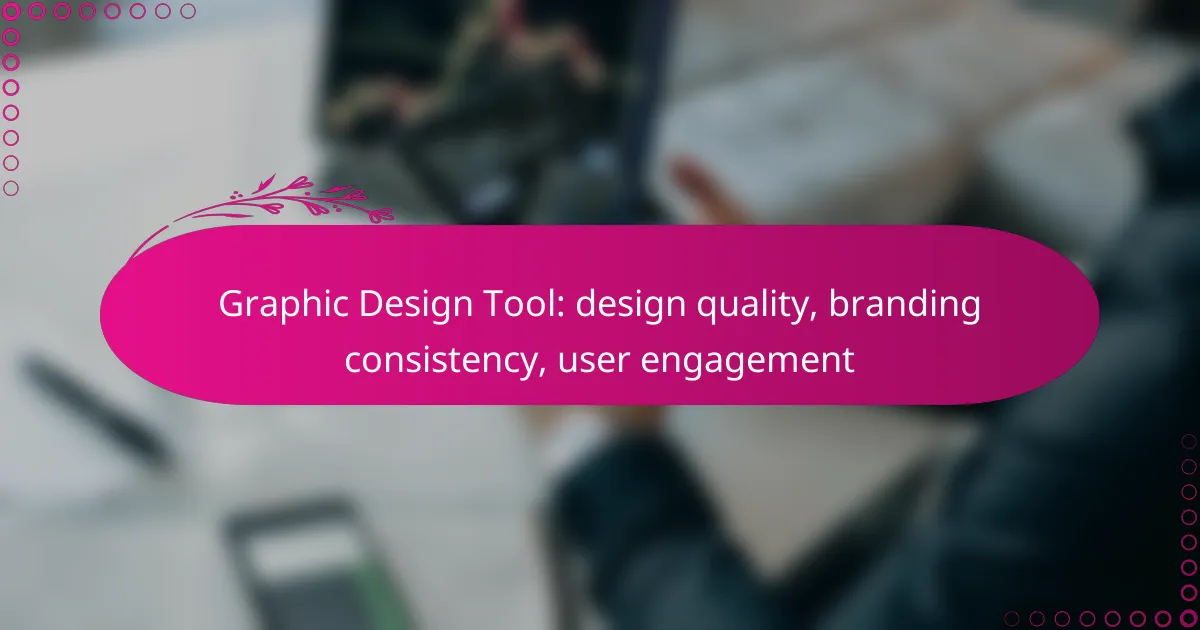Graphic design tools play a crucial role in enhancing design quality and ensuring branding consistency. By offering advanced editing features and maintaining uniformity in visual elements, these tools help create engaging content that resonates with audiences. Ultimately, they empower designers to produce professional and visually appealing materials that foster user interaction and satisfaction.
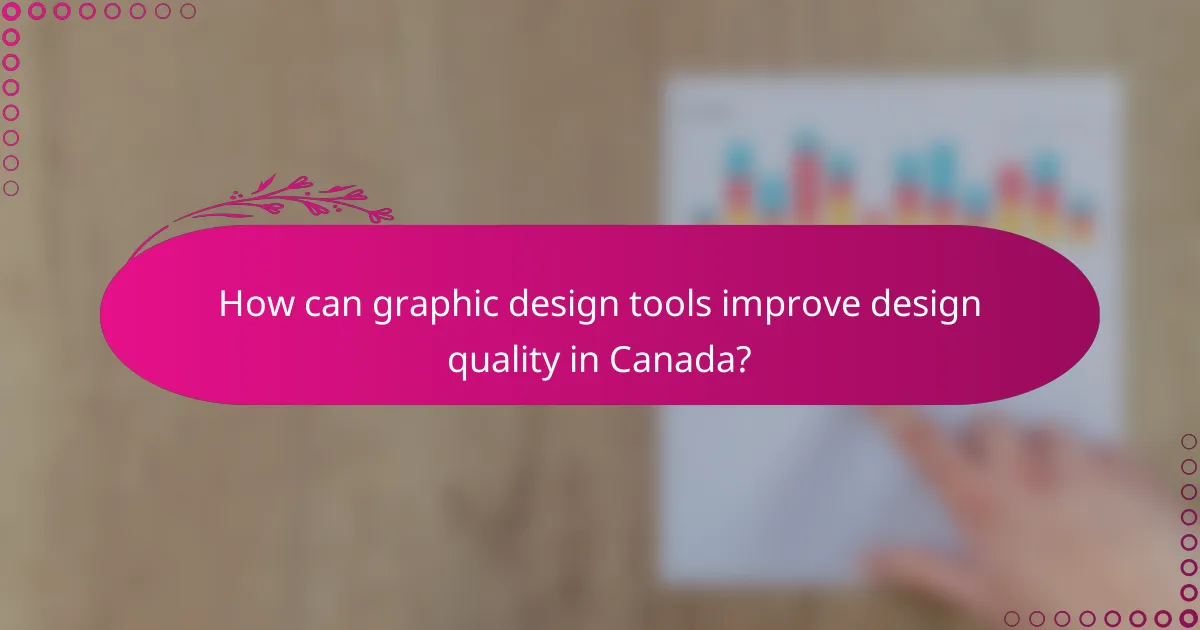
How can graphic design tools improve design quality in Canada?
Graphic design tools enhance design quality in Canada by providing features that ensure high-resolution images, advanced editing options, and effective collaboration. These tools help designers create visually appealing content that aligns with branding standards and engages users effectively.
Enhanced image resolution
Graphic design tools often support high-resolution outputs, which is crucial for maintaining quality across various media. In Canada, where print and digital standards are high, using tools that allow for resolutions of 300 DPI or higher can significantly improve the clarity of images.
When selecting a tool, look for options that offer vector graphics capabilities, as these can be resized without losing quality. This is particularly beneficial for logos and branding materials that need to be adaptable for different formats.
Advanced editing features
Advanced editing features in graphic design tools allow for precise adjustments to images and layouts. Tools that offer layer management, masking, and color correction can help designers refine their work to meet specific branding requirements.
Consider tools that provide user-friendly interfaces for complex functions, such as Adobe Photoshop or Affinity Designer. These features can save time and enhance the overall design quality by enabling quick iterations and adjustments.
Collaboration capabilities
Collaboration capabilities are essential for teams working on graphic design projects. Many modern tools offer cloud-based solutions that allow multiple users to work on a project simultaneously, making it easier to share feedback and make real-time changes.
Look for tools that integrate with project management software or provide commenting features. This can streamline communication and ensure that all team members are aligned with the design vision, ultimately improving the quality and consistency of the final product.
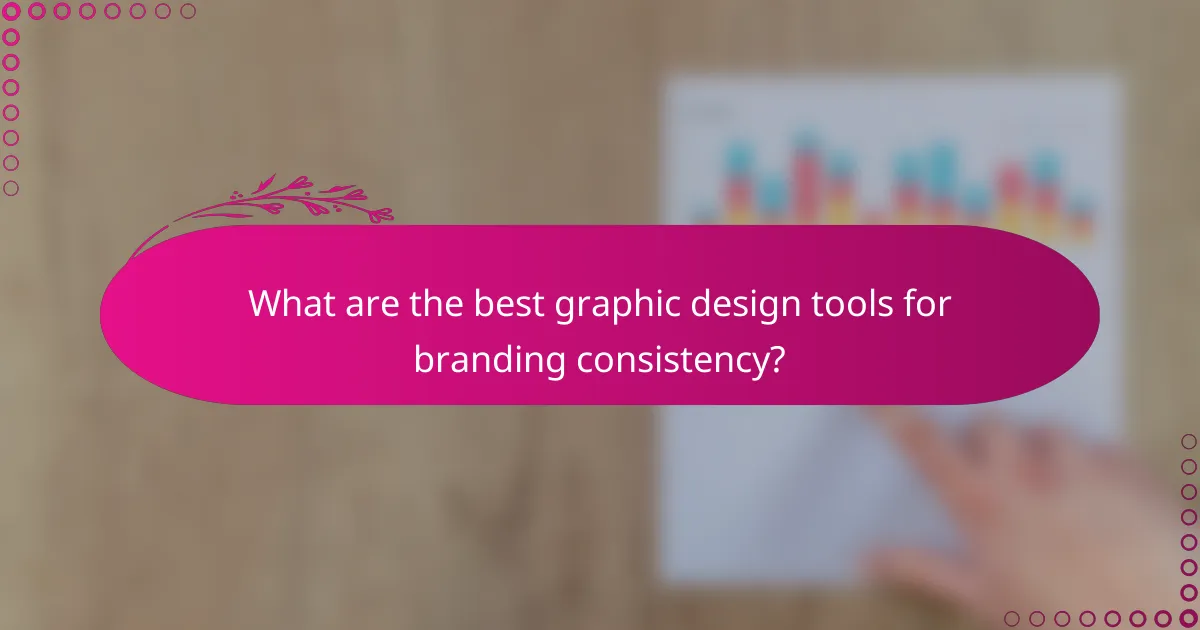
What are the best graphic design tools for branding consistency?
The best graphic design tools for branding consistency enable users to create cohesive visual identities across various platforms. These tools help maintain uniformity in colors, fonts, and logos, ensuring that branding remains recognizable and professional.
Canva for brand kits
Canva offers a user-friendly platform that allows businesses to create brand kits, which include logos, color palettes, and typography guidelines. This feature ensures that all design elements are aligned with the brand’s identity, making it easy to produce consistent marketing materials.
With Canva’s drag-and-drop interface, users can quickly design social media posts, presentations, and other graphics while adhering to their established brand guidelines. This saves time and reduces the risk of deviating from the brand’s visual standards.
Adobe Creative Cloud for templates
Adobe Creative Cloud provides a suite of professional design tools that include customizable templates for various media. These templates can be tailored to fit brand specifications, ensuring that all outputs reflect the same branding elements.
Using Adobe’s extensive library of assets, designers can maintain consistency across print and digital platforms. However, the learning curve can be steep, so it’s important to invest time in mastering the tools to fully leverage their capabilities.
Visme for visual storytelling
Visme specializes in creating engaging visual content that supports branding consistency through storytelling. It offers templates and design elements that can be easily customized to align with brand identities, making it ideal for presentations and infographics.
By utilizing Visme, brands can create visually appealing narratives that resonate with their audience while maintaining a consistent look and feel. This tool is particularly useful for marketers looking to enhance user engagement through compelling visuals.
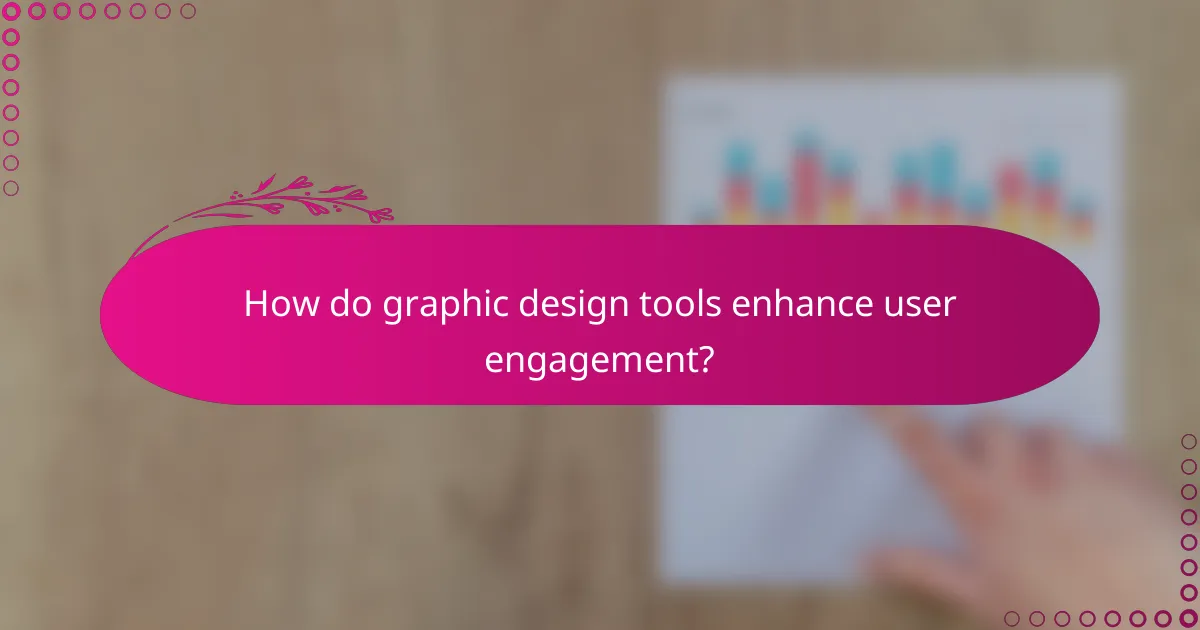
How do graphic design tools enhance user engagement?
Graphic design tools significantly enhance user engagement by providing features that facilitate interaction, personalization, and immediate feedback. These tools empower users to create visually appealing content that resonates with their audience, ultimately driving higher levels of interaction and satisfaction.
Interactive design elements
Interactive design elements, such as buttons, sliders, and animations, play a crucial role in engaging users. By incorporating these features, designers can create a dynamic experience that encourages users to explore and interact with the content. For example, a website with animated buttons can draw attention and prompt users to click, increasing overall engagement.
When using interactive elements, it’s essential to ensure they are intuitive and enhance the user experience rather than distract from it. Avoid overwhelming users with too many animations; instead, focus on a few key elements that guide them through the content effectively.
Customizable templates
Customizable templates allow users to tailor designs to their specific branding needs, which is vital for maintaining consistency across various platforms. These templates can be easily modified to reflect a brand’s colors, fonts, and imagery, ensuring that all materials resonate with the target audience. For instance, a company can use a template for social media posts that aligns with its overall branding strategy.
When selecting a template, consider the flexibility it offers. Look for templates that allow for easy adjustments without compromising the design’s integrity. This adaptability can significantly enhance user engagement by making content feel more personalized and relevant.
Real-time feedback features
Real-time feedback features enable users to receive immediate responses to their design choices, fostering a more interactive experience. Tools that offer live previews or collaborative editing allow users to see changes as they happen, which can enhance creativity and engagement. For example, a graphic design tool that shows how a color change affects the overall design instantly can help users make informed decisions.
Incorporating real-time feedback can also streamline the design process. Encourage users to utilize these features to experiment with different design elements without the fear of making irreversible changes. This approach not only boosts confidence but also enhances user engagement through active participation in the design process.
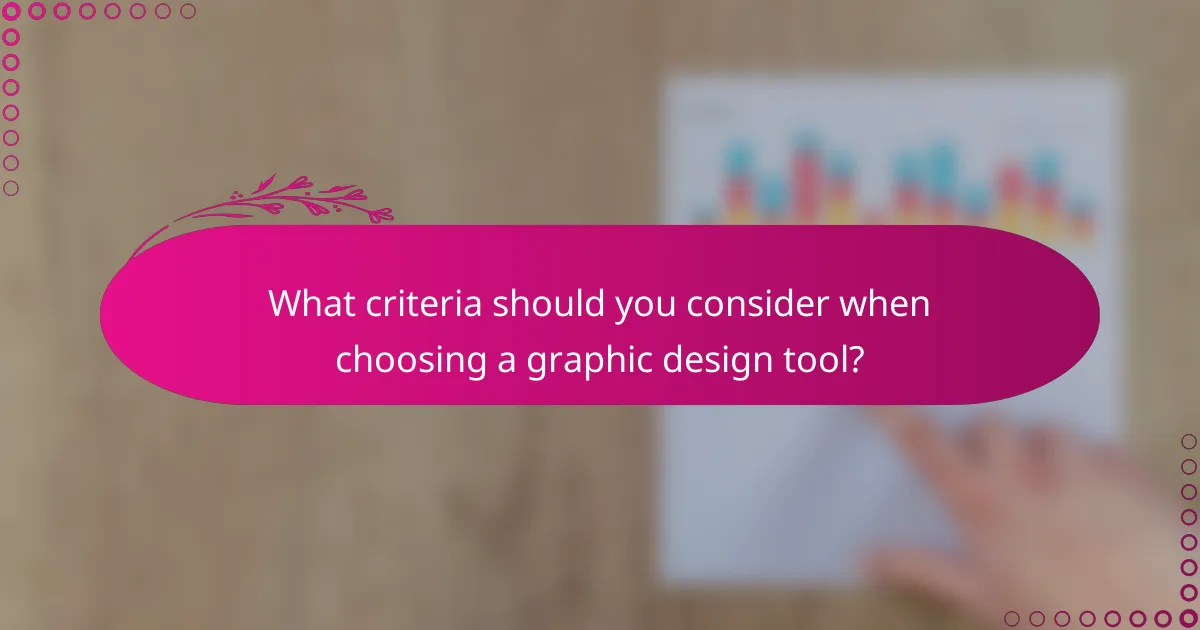
What criteria should you consider when choosing a graphic design tool?
When selecting a graphic design tool, consider factors such as ease of use, integration capabilities, and pricing plans. These criteria will help ensure the tool meets your design needs while supporting your branding and user engagement goals.
Ease of use
Ease of use is crucial for maximizing productivity and minimizing frustration. Look for tools with intuitive interfaces that allow you to quickly navigate features and functions. A user-friendly design can significantly reduce the learning curve, enabling you to focus on creating rather than troubleshooting.
Consider tools that offer templates and pre-designed elements, as these can streamline your workflow. For example, platforms like Canva provide drag-and-drop functionality, making it easy for beginners to produce professional-quality designs without extensive training.
Integration with other tools
Integration with other software can enhance your design process by allowing seamless data transfer and collaboration. Check if the graphic design tool can connect with platforms you already use, such as project management software, social media, or content management systems.
For instance, tools like Adobe Creative Cloud integrate well with various applications, enabling you to work efficiently across different projects. Ensure the tool supports APIs or plugins that facilitate these connections, enhancing your overall productivity.
Pricing plans
Pricing plans vary widely among graphic design tools, so it’s essential to find one that fits your budget while offering the necessary features. Many tools offer tiered pricing, allowing you to choose a plan based on your needs, whether for individual use or team collaboration.
Evaluate what each plan includes, such as access to premium features, storage options, or customer support. Some tools may offer free trials or freemium models, allowing you to test their capabilities before committing financially. Always consider the long-term value of the tool in relation to your design goals.

How do graphic design tools support marketing strategies in Canada?
Graphic design tools enhance marketing strategies in Canada by ensuring high design quality, maintaining branding consistency, and boosting user engagement. These tools enable marketers to create visually appealing content that resonates with their target audience while adhering to brand guidelines.
Consistent branding across platforms
Consistent branding is crucial for building trust and recognition among consumers. Graphic design tools allow marketers to create templates that ensure uniformity in colors, fonts, and logos across various platforms, such as websites, social media, and print materials.
For example, using a design tool, a company can develop a set of brand guidelines that dictate how their logo should appear on different backgrounds or how their color palette should be applied in various contexts. This consistency helps reinforce brand identity and makes it easier for customers to recognize the brand.
Data-driven design insights
Data-driven design insights help marketers make informed decisions about their graphic content. Many design tools offer analytics features that track user engagement metrics, such as click-through rates and conversion rates, allowing marketers to understand what designs resonate best with their audience.
By analyzing this data, marketers can refine their graphics to improve performance. For instance, if a particular color scheme leads to higher engagement, they can adjust their designs accordingly to optimize user interaction.
Social media integration
Social media integration is essential for effective marketing in today’s digital landscape. Graphic design tools often include features that allow users to create and publish content directly to social media platforms, streamlining the process and ensuring that designs are optimized for each platform’s specifications.
For example, a marketer can use a design tool to create a visually striking Instagram post that meets the platform’s size requirements and includes engaging elements like hashtags or calls to action. This integration not only saves time but also enhances the overall effectiveness of social media campaigns.
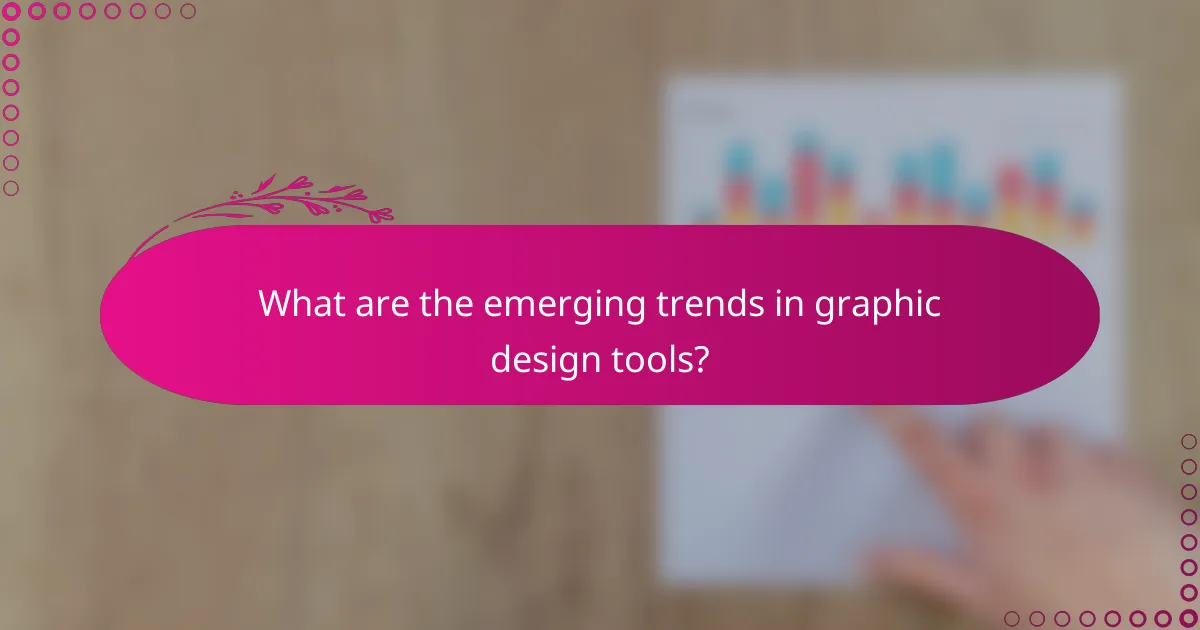
What are the emerging trends in graphic design tools?
Emerging trends in graphic design tools focus on enhancing user experience through advanced technologies and features. Key developments include AI-driven design suggestions and augmented reality capabilities, both of which aim to improve design quality and branding consistency while boosting user engagement.
AI-driven design suggestions
AI-driven design suggestions leverage machine learning algorithms to analyze user preferences and design trends, offering tailored recommendations. These tools can suggest color palettes, layouts, and typography based on the specific context of the project, making the design process more efficient.
For instance, platforms like Canva and Adobe Spark utilize AI to help users create visually appealing designs quickly. This can significantly reduce the time spent on brainstorming and revisions, allowing designers to focus on more creative aspects.
When using AI-driven tools, it’s essential to maintain a balance between automation and personal creativity. Over-reliance on AI can lead to generic designs, so always customize suggestions to align with your brand’s identity.
Augmented reality features
Augmented reality (AR) features in graphic design tools allow users to visualize their designs in real-world settings. This technology enhances user engagement by providing interactive experiences, such as placing virtual objects in physical spaces through mobile devices.
Applications like Adobe Aero enable designers to create AR experiences without extensive coding knowledge. This can be particularly useful for marketing campaigns, where potential customers can see how products fit into their lives before making a purchase.
To effectively use AR in design, ensure that the augmented elements are relevant and enhance the overall user experience. Avoid cluttering the visual space, as this can detract from the intended message and confuse users.
